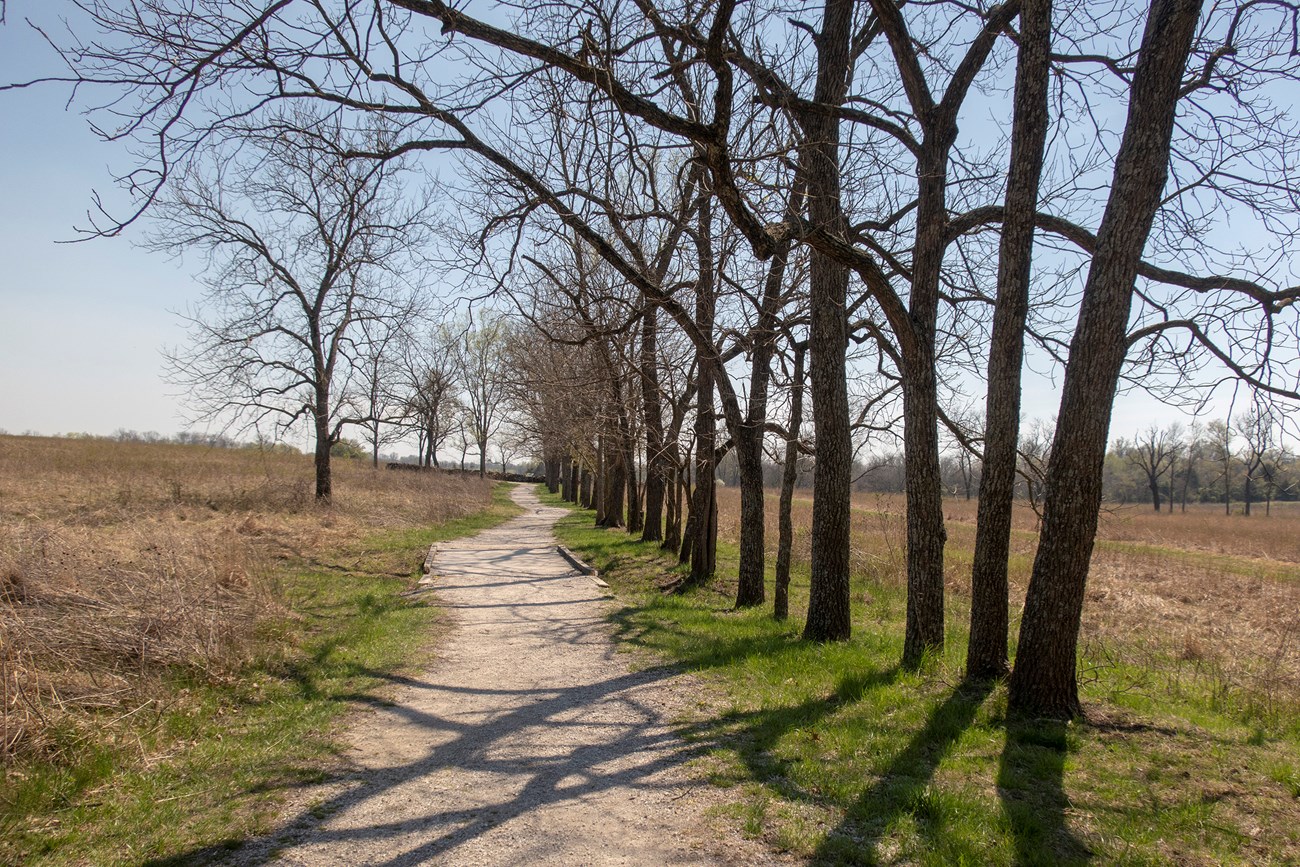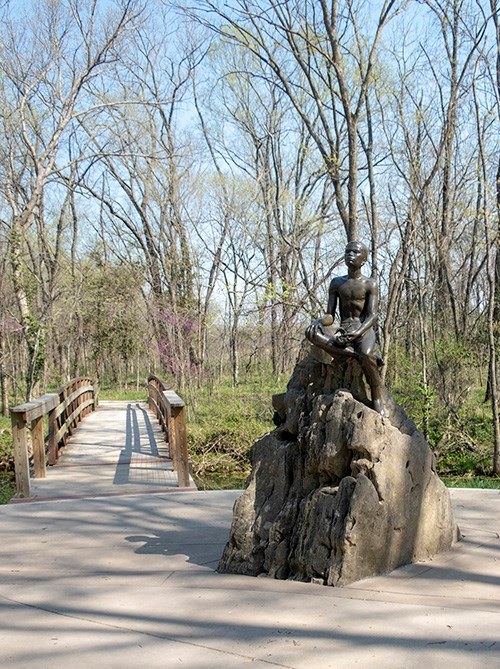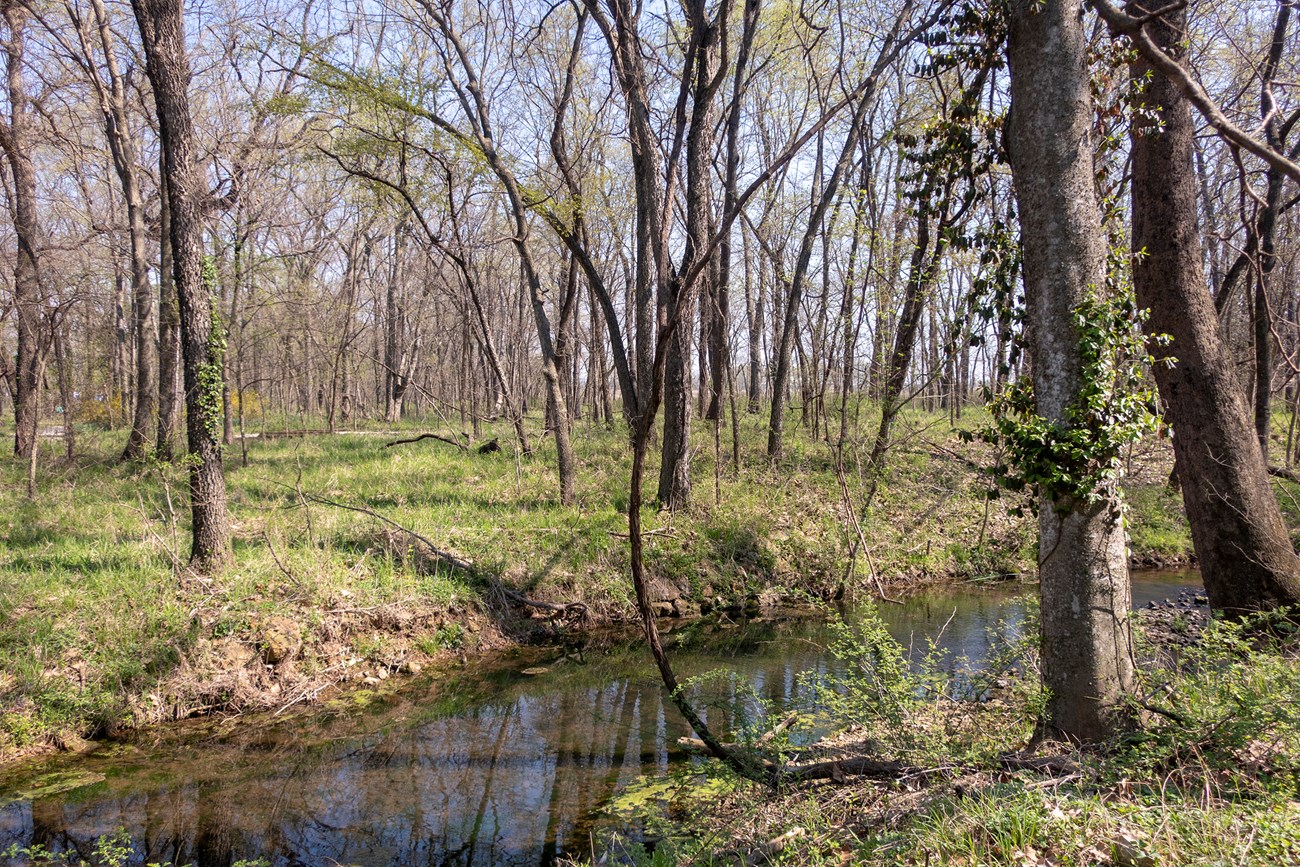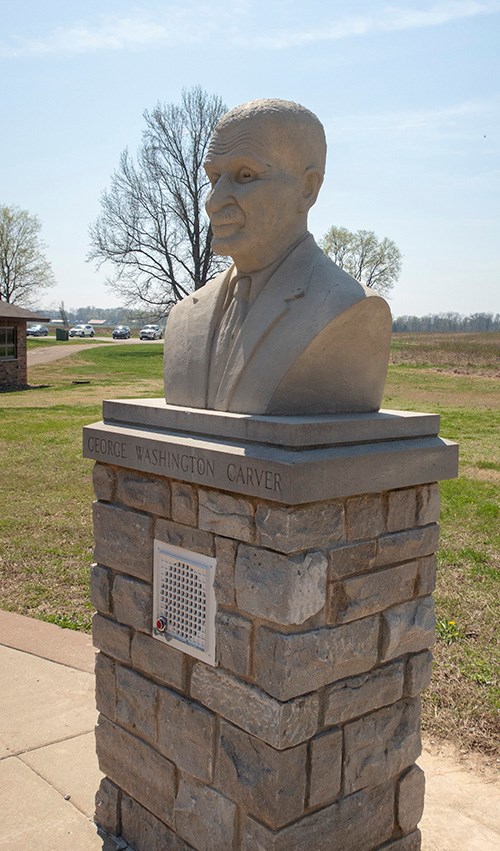Last updated: December 3, 2019
Article
George Washington Carver National Monument Cultural Landscape

NPS
George Washington Carver National Monument occupies 240 acres of historic farmland in Diamond, Missouri. The site's primary significance arises from its association with George Washington Carver: accomplished botanist, agronomist, conservationist, humanitarian, and teacher.
Carver, born to an enslaved mother towards the end of the Civil War, spent his childhood with his brother Jim, as orphans at Moses Carver’s farm from his birth in 1865 until 1876. Moses Carver and his wife, Susan, originally owned the farmstead on which they raised livestock, cultivated orchards, and grew corn among other crops. Although the Missouri State constitutional convention legally ended slavery in 1865, George stayed and worked on the farm until he was 11 years old. When not working, he collected plant specimens from the nearby woods and developed an appreciation for nature.
As the first national park established to honor a black American, George Washington Carver National Monument assumes further significance. Its second period of significance starts with the site's dedication in 1943 and continues to 1960 for the addition of the commemorative and interpretive elements.
Landscape Description
The National Monument demonstrates historic integrity, or the ability to convey its association with George Washington Carver and his commemoration, through the retention of the original location and maintenance of other aspects related to both periods of significance.During the first period of significance associated with Carver’s boyhood from 1865-1876, the site contained cropland, prairie, woodlands, orchards, and livestock areas. Today, the majority of the undeveloped portion of the park is maintained as a restored prairie. Agricultural properties surround the park, which contribute to the setting.

NPS
The site’s contributing features related to the second period of significance, or Carver’s commemoration, include the George Washington Carver bust, "Boy Carver" statue, dedication plaque and boulder, walnut fence row, and cemetery wall reconstruction. The mile-long Carver Nature Trail connects and sequences the interpretive features of the landscape. Visitors first encounter the "Boy Carver" statue along the trail, then the Moses Carver House, open prairie, and Carver Family Cemetery before arrival back at the Carver Bust and the visitor center.
Historic Use
George Washington Carver wrote in his autobiography, “day after day I spent in the woods alone in order to collect my floral beauties, and put them in my little garden.” As a sickly child, Carver primarily handled less physically demanding or domestic tasks and spent his free time cultivating native flora. Community members referred to Carver as the “plant doctor” in his youth.
NPS
In 1896, Booker T. Washington offered him a position as department head of Agriculture at Tuskegee Institute in Alabama. During his 47 years at Tuskegee, Carver educated farmers and the public on conservation, organic farming, and sustainable agricultural practices. Crop rotation proved integral in confronting the depletion of soil fertility in the rural South from an overdependence on cotton crops. Under Carver’s guidance, southern farmers began growing alternative nitrogen-fixing crops like sweet potatoes and peanuts. Carver also received patents for several industrial applications of common crops.
George Washington Carver invented over 300 uses for the peanut and 100 for the sweet potato, which helped create demand for poor southern farmers producing the crops.

NPS
After Carver’s death in 1943, President Franklin D. Roosevelt signed legislation for the creation of a national monument at the former Moses Carver farm. The nature trail and commemorative plaque were among the first features added to the site. In 1958, under the Mission 66 program which intended to expand and modernize the National Park System, administrators approved a prospectus for a new visitor center and museum. Construction on the visitor center along with a new entrance road and parking area started the following year. The second period of significance ended in 1960 with the addition of the "Boy Carver" Statue -- the last major commemorative element.
Today, the National Monument honors George Washington Carver’s legacy and provides visitors the opportunity for reflection, solitude, and learning.
Additional Site Associated with George Washington Carver
In 1886, after being denied enrollement at Highland College, Carver moved to Beeler, Kansas and filed a homestead claim for 160 acres. He lived and worked on his homestead for two years. Carver developed the site by adding a non-extant sod house, crop fields, and trees. The George Washington Carver Homestead Site was added to the National Register of Historic Places in 1977.Landscape Timeline
| Date | Event |
|---|---|
| 1865 | Carver was born to Mary at Moses Carver’s farm in Diamond, Missouri. His exact birth date is unknown. Slavery was abolished in Missouri on January 11. |
| 1876 | Carver left the farm to attend Neosho Colored School in Neosho, Missouri. |
| 1890 | Carver attended art school at Simpson College in Iowa. |
| 1891 | Carver left Simpson College to attend school at Iowa State Agricultural College. |
| 1896 | After graduation from Iowa State, Carver served as head of the Agriculture Department at Tuskegee Institute. During his 47 years there, he promoted sustainable farming practices including crop rotation. He also invented uses for peanuts and sweet potatoes. |
| 1910 | Moses Carver died and the property was sold to Samuel Warden. |
| 1913 | Property purchased by C.M. Shartel who used the land for cattle raising operations. This altered the landscape through the expansion of grazing land and built structures. |
| 1941 | St. Louis branch of the National Association for the Advancement of Colored People (NAACP) submitted a proposal for the birthplace memorial. |
| 1943 | Carver passed away. Congress authorized the National Monument on July 14. |
| 1950 | Acquisition of the property was delayed but additional funds allowed the federal government to acquire 210-acres of the property |
| 1953 | Dedication of the monument occurred with the presentation of the George Washington Carver bust and development of Carver Trail. |
| 1958 | Mission 66 plans for the park approved, which included a visitor center and museum building. |
| 1960 | Dedication of the new visitor center and addition of the "Boy Carver" statue. |
| 2005 | NPS acquired the final 30 acres of the original Moses Carver Farm, restoring the historic property to its original size and configuration. |
| 2007 | Visitor center renovated and a 6,700 square foot addition added. |
Quick Facts
- Cultural Landscape Type: Historic site
- National Register Significance Level: National
- National Register Significance Criteria: A, B, D
- Period of Significance:
1943-1960: Commemorative features added to the site ending with placement of the "Boy Carver" statue
Landscape Links
- George Washington Carver National Monument Cultural Landscape Report and Environmental Assessment
- George Washington Carver National Monument Historic Resource Study and Administrative History
- National Register of Historic Places: George Washington Carver National Monument
- Landscape Flickr Album
- More about NPS Cultural Landscapes


